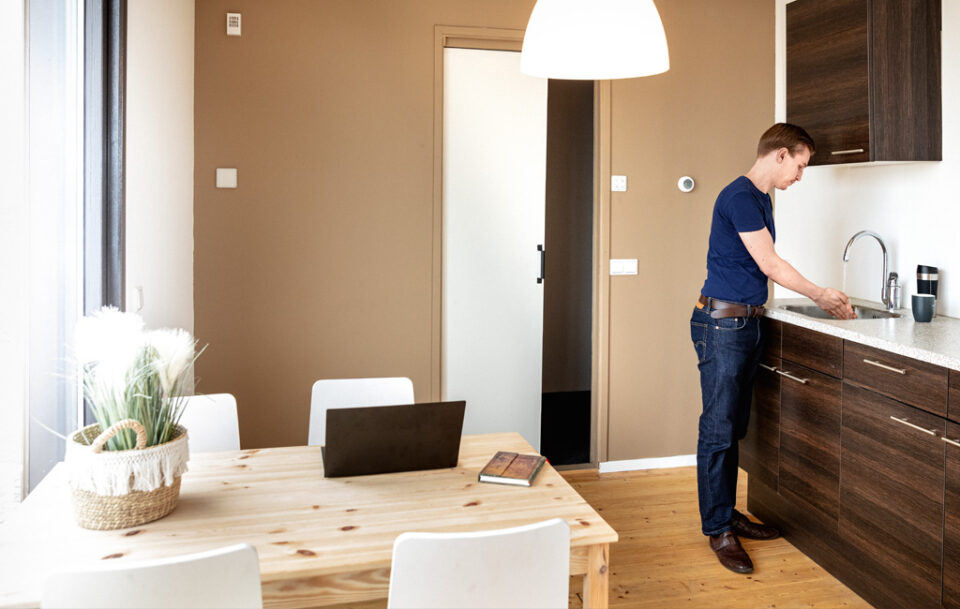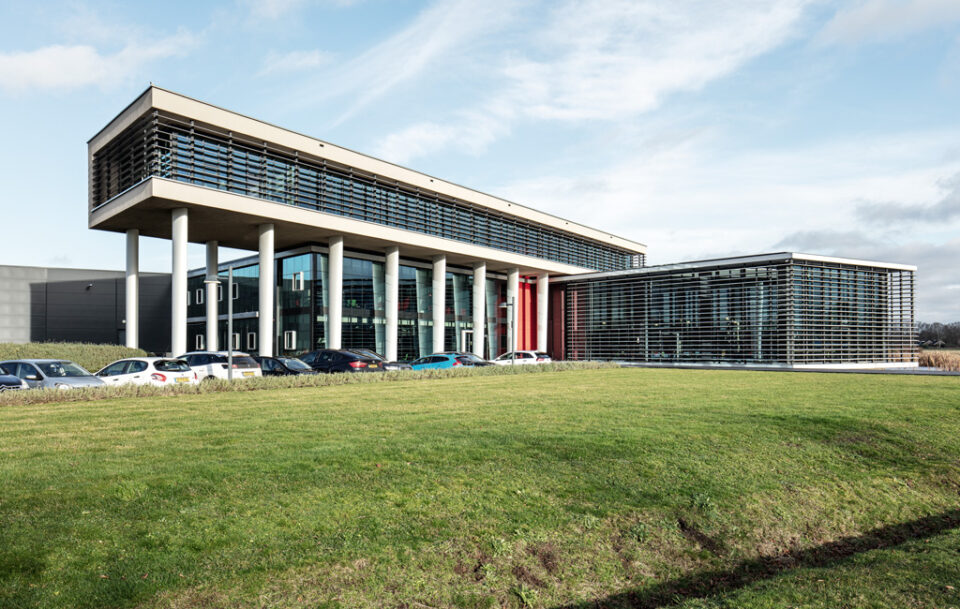“Exciting!” When Gerrit Zijlstra talks about the tiny house, he get’s excited. It is not even the cube’s modern coziness, measuring 3.45 by 11.95 meters, that makes the physicist light up. In fact, the reason he is so excited cannot even be seen. Instead, it is something that is felt: despite the Netherlands’ winter winds, the tiny house has a cozy temperature and the water in the house heats up quickly, allowing for a pleasant hot shower to warm you up. This is a milestone for Zijlstra and his employer, Dutch boiler manufacturer Intergas, based in Coevorden. This is because their boiler in the tiny house provides hot water and warmth, heating entirely with hydrogen.
Hydrogen is both: storage and energy, which makes it an effective solution for the energy transition. Therefore we are exploring this as a solution.
Peter Cool, CTO Intergas
“For me, this is what is fascinating about the tiny house project: integrating new hydrogen technology into a tried-and-tested product like a boiler and finding a solution for sustainable fuel. This enables us to reduce CO₂ emissions,” says Zijlstra. Two years ago, Intergas embarked on this path. Because, as CTO Peter Cool says: “Hydrogen is both: storage and energy, which makes it an effective solution for the energy transition. Therefore we explore this as a solution.” Developer Zijlstra took on the H2 capability of Intergas’ products as project manager for hydrogen. The first question to ask was, “How can we convert an existing boiler so that it can burn pure hydrogen?”

Photo: Miquel Gonzalez | Fotogloria
Tests in the hydrogen laboratory
The search for answers began in the company’s own hydrogen laboratory. First of all, that meant going back to the basic principles of combustion technology. After all, hydrogen behaves completely differently to natural gas, which is going to be replaced as part of the energy transformation in the not-too-distant future. Zijlstra explains, “With natural gas, we use its conductivity to monitor the flame. In contrast, a hydrogen flame is not conductive and is almost invisible. So first of all, we had to find a solution to ensure flame monitoring.”
The hydrogen boiler is the result of an innovative collaboration with a fantastic team of experts.
Gerrit Zijlstra, developer at Intergas
With a wide range of test setups and open burners, Zijlstra got to work at the laboratory, with the major advantage that Intergas has short chains of command between the disciplines required for an advanced boiler: “The hydrogen boiler is the result of an innovative collaboration with a fantastic team of specialists who excel in electronics, physics, embedded software, engineering, certification, IT, product management, and marketing,” says Zijlstra.
Close links during the development
There are close links beyond the company and national borders too. “We brought ebm-papst on board at the start of our work on the H2 boiler. After all, we suspected early on that the gas valve and the blower would play a crucial role. We already had very good contact with ebm-papst through Enno Vrolijk, the head of gas valve development.”
In Enno Vrolijk, Jürgen Schwalme, head of application and certification, the applicator Christoph Beck, and Ludwig Hirsch, head of the test workshop, Intergas found contact persons who can provide both technical support as well as help with all necessary formalities. “We had a lot of interesting discussions and identified potential risks together. ebm-papst also provided us with prototypes that are tailored to the characteristics of hydrogen,” says Zijlstra. These include, for example, a particularly tight gas blower and special hydrogen settings for gas valves. However, it also had to be ensured that no sparks from electrostatic charging occur inside the blower even if there’s a fault. The fact that ebm-papst has been dealing with the element H2 for some time quickly paid off for Intergas.
Help with certification
“As heating experts we are all about development, development, development,” says Zijlstra. So when they got an exciting inqiry their motivation was boosted even further: various institutions of the community of Hoogeveen had come together to build a small mobile house made entirely of sustainable materials, and operated with green hydrogen. In September 2021, the “Waterstof Tiny House” was set to go on tour through the Dutch region of Drenthe as an ambassador for green living and to inspire the wider population, students, and those with a professional interest. This was the ideal demonstration test for Intergas and its first H2 boiler. However, by then, it was March already, so there was limited time.
A major challenge for us was that the technology is further along than the regulations.
Gerrit Zijlstra, developer at Intergas
“A major challenge for us was that the technology is further along than the regulations. We were unable to use certified components because there simply weren’t any certifications,” says Zijlstra. “But ebm-papst helped us in the certification process that we had to undergo for the tiny house demonstration test.” Expert Jürgen Schwalme explains: “Even before the tiny house project, we had sat with different testing centers, such as DVGW-EBI, and worked with them to evaluate risk analyses and to determine and perform the necessary tests and investigations. We also participated in the European ‘Testing Hydrogen in Gas Appliances’ project, or THyGA for short, and were invited in the standards consortium to participate in drafting the European guideline for the use of 100 percent hydrogen for gas valves in heating technology. Our network in Europe enabled us to provide Intergas with very quick support in the collaboration with Dutch testing center Kiwa.”

Hot water on the march with hydrogen: The Waterstof Tiny House was on tour through the Netherlands as an ambassador for green heating. (Photo: Miquel Gonzalez | Fotogloria)
From tiny house to residential area
Since then, the tiny house has completed its tour and has left a lot of lasting impressions. “The visitors were thoroughly impressed, and the first thing many of them did was check whether warm water actually comes out of the tap,” says Zijlstra, who was there himself at some stops.
The tiny house is now at its final location in Hoogeveen, and Intergas is starting its next hydrogen project: a part of the village Wagenborgen in Groningen, with houses from the 1970s, will be connected to a hydrogen network at the end of 2022. From that moment on the residents of 33 houses will heat with a hybrid system — with hydrogen boilers and small heat pumps from Intergas.
With the 100 percent hydrogen boiler we are ready for a sustainable future. This is pretty exciting for us.
Gerrit Zijlstra, developer at Intergas
However, with older houses, some of which are even listed as a historical monument, it is often not possible to install heat pumps for heating to bring them up to a level that is in line with the energy transformation. “For these houses, hydrogen is a simple solution that is also quick to install: based upon our experience with current gas boilers, an installer only requires a morning to install an H2 boiler. With hydrogen technology, we can accelerate the transformation,” says Gerrit Zijlstra, adding: “With the 100 percent hydrogen boiler we are ready for a sustainable future. This is pretty exciting for us.”





Leave a comment